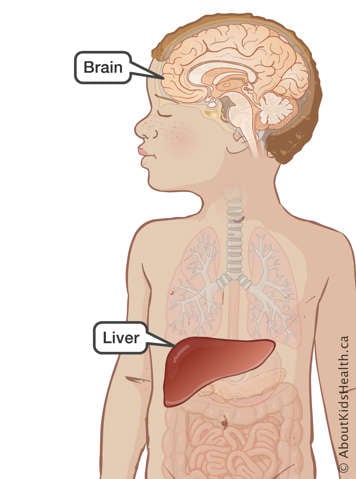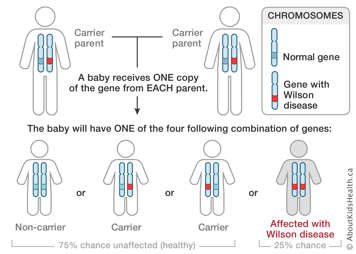What is Wilson disease?
Wilson disease is a genetic disorder that allows copper to build up in the body and cause damage.
Our body needs a small amount of copper
To work well, our body needs a small amount copper. Copper is a metallic element. It helps keep the immune system healthy, build strong bones and form red blood cells. We absorb copper from a variety of food such a nuts, seeds, oysters and liver. Normally, our bodies regularly dispose of copper to prevent it from accumulating in the body.
Too much copper damages the tissues
Some children are unable to get rid of copper. This inability is a disorder called Wilson disease. The excess copper is stored in the main organs, such as the liver, brain, kidneys and eyes. In the liver, extra copper causes damage and scarring. This causes the liver to stop working correctly.
Signs and symptoms of Wilson disorder
Symptoms are more likely in children 10 years and older. In Wilson disease, copper usually accumulates in the liver and brain. This is why symptoms are mainly liver disease and neurological problems.

Symptoms of liver disease
- tiredness
- yellow skin (jaundice) or yellow colour of the white of the eyes
- enlargement of the abdomen
- vomiting blood
Symptoms of neurological problems
- confusion
- emotional or behavioral changes such as depression, anxiety and psychosis
- slow or decreased movement
- slurred speech
- tremors in the hands
- clumsiness
- worsening of academic performance
Wilson disease is a genetic disease
A change or mutation in a gene causes Wilson disease. Children are born with it.
If a person has one copy of this gene they are a carrier of the disease. About one in 100 people carry this gene. A child needs to be born with two copies of the gene to develop the disease. If both parents carry the gene for Wilson disease, there is a 25% chance their child will have the disorder.

How common is Wilson disease?
About one in 30,000 people have Wilson disease. It is most common in eastern Europeans, Sicilians and southern Italians. Wilson disease typically appears in people under 20 years old. In children, it is rarely diagnosed before the age of four years. Younger children rarely show any symptoms. Doctors suspect Wilson disease during routine blood tests.
Diagnosis of Wilson disease
If your child experiences the symptoms listed above or there is a known family history, the doctor may suspect Wilson disease.
Blood tests
To help confirm the diagnosis, the doctor will take a sample of your child's blood. They will test for:
- The amount of copper in the blood.
- The presence of liver enzymes. High levels of these enzymes mean the liver cells are damaged.
- The amount of a liver protein called albumin. Albumin levels decrease in the blood when the liver is damaged.
- How long it takes for the blood to clot
- The amount of a protein which transports copper in the blood, called ceruloplasmin. Its levels are lower in Wilson disease.
The health care team will arrange for you to collect your child's urine over a 24-hour period. This will be explained in more detail when you are in clinic. They test the urine for copper levels.
Excess copper in the eyes can cause dark rings to form around the iris. These are called Kayser-Fleischer rings. They are difficult to see without a special eye exam. Your child's doctor may do an eye exam to check for these rings. However, the absence of the Kayser-Fleischer rings does not rule out the disease.
Your child's health care team may do other tests such as an ultrasound of the abdomen and a CT scan or MRI of the brain.
Liver biopsy
After finding signs that suggest Wilson disease, your child's doctor will take a sample of the liver. They check for specific changes in the liver. They also measure the amount of copper in the liver.
Genetic test for Wilson disease
The doctor may use a sample of your child's blood to run a genetic test for the Wilson disease gene. You will likely wait several weeks before finding out the results of the test.
Treatment for Wilson disease
Wilson disease is a life-long disease. However, your child can lead a better quality of life and avoid serious complications by carefully following the treatment plan.
The goal of treatment is to lower the amount of copper in the tissues. It requires a life-long commitment, which involves:
Eating a low copper diet
Your child should try to avoid eating the following copper-rich foods:
- chocolate
- dried fruit
- mushrooms
- nuts
- liver
- shell fish
Taking prescribed medicines
- Zinc tablets which helps block copper from being absorbed in your intestines
- Penicillamine or trientene. These medicines bind with copper in the body and then both are excreted in the urine.
Continual monitoring
Your child's health care team will book follow-up appointments to:
- Ensure they are consistently taking medicines. Do routine blood tests to check the levels of liver enzymes and copper. This happens every four to six months.
- Collect urine samples for 24 hours to check for copper levels. Your child's health care team will do this about one to two times a year.
Liver transplant
In more serious cases, your child may be considered for a liver transplant. If this is an option for your child, the doctor will discuss the procedure more clearly with you.
Communicate with your child's health care team
Wilson's disease is a life-long condition. It is important to maintain open communication with your child's health care team. Talk openly with the doctor if you have any questions or concerns about your child's treatment. Make sure you update the doctor with any new symptoms your child may experience. Remember the health care team is there to support you and your child.
